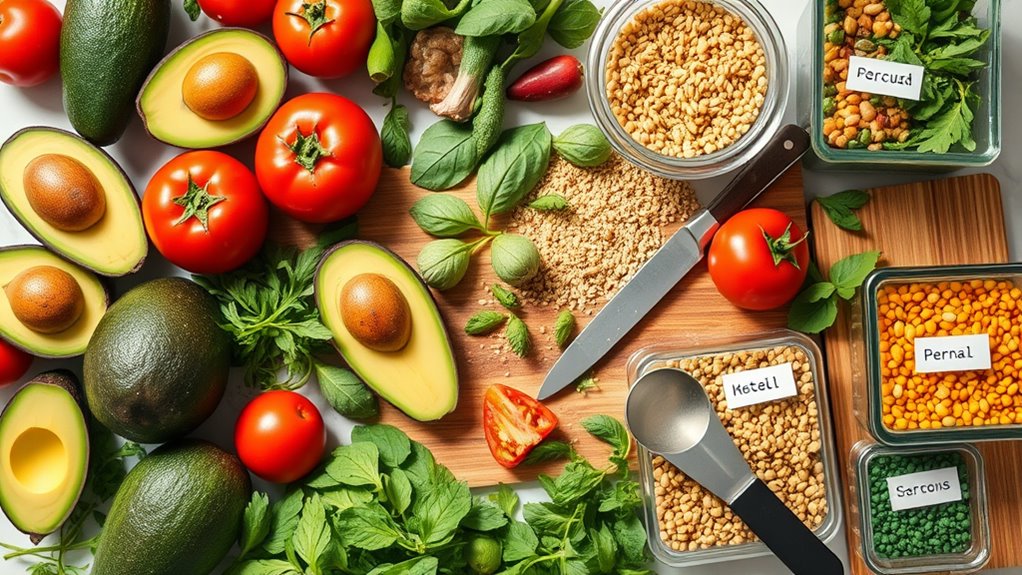How I Built a Clean Eating Meal Plan That Works
Creating a clean eating meal plan that works for you involves more than just choosing healthy foods. It starts with understanding your dietary needs and preferences, which can help you select nutrient-dense options that fuel your body effectively. By establishing a structured weekly meal schedule and incorporating practical meal prep strategies, you can simplify the process. But how do you ensure this plan stays sustainable and effective over time? Let’s explore the key steps to make it happen.
Understanding Clean Eating Principles
What does clean eating really mean? It’s about choosing whole, unprocessed foods that nourish your body.
A clean eating plan emphasizes fruits, vegetables, whole grains, lean proteins, and healthy fats while minimizing added sugars, sodium, and artificial additives. By focusing on these foods, you’re not just fueling your body; you’re also enhancing overall health and well-being. This approach encourages mindful eating habits, helping you to appreciate the flavors and textures of natural foods. As you develop your clean eating plan, remember that balance is key—enjoying occasional treats is part of a sustainable lifestyle, too. Incorporating easy clean eating ideas into your routine can simplify meal preparation and make healthier choices more accessible.
Assessing My Dietary Needs
To create a successful clean eating meal plan, you first need to assess your dietary needs.
Start by identifying your nutritional goals, understanding any food sensitivities, and evaluating your lifestyle constraints.
This will help you tailor your meal plan to fit your unique requirements and promote better health. Additionally, considering balancing nutrition is crucial for ensuring that all food groups are represented in your meals.
Identifying Nutritional Goals
How can you effectively assess your dietary needs to create a clean eating meal plan?
Start by identifying your nutritional goals.
Consider these factors that may resonate with you:
-
Energy levels: What foods fuel your daily activities?
-
Weight management: Are you aiming to lose, gain, or maintain weight?
-
Health conditions: Do you have any specific health concerns that require attention?
Understanding Food Sensitivities
Identifying food sensitivities is crucial for tailoring your clean eating meal plan effectively. It helps you avoid ingredients that can cause discomfort or digestive issues. Start by tracking what you eat and how it affects you. Here’s a simple table to help you assess your sensitivities:
| Food Type | Symptoms Noted | Elimination Period |
|—————-|———————-|——————–|
| Dairy | Bloating, Fatigue | 2 weeks |
| Gluten | Headaches, Gas | 2 weeks |
| Nuts | Rashes, Digestive Issues | 2 weeks |
Evaluating Lifestyle Constraints
Once you’ve recognized your food sensitivities, it’s time to consider how your lifestyle influences your dietary needs.
Think about how your daily routine, work schedule, and social life shape your eating habits.
-
Do you often eat on the go?
-
Are you frequently dining out with friends?
-
How much time can you dedicate to meal prep?
Evaluating these factors helps you create a realistic meal plan that fits your life.
Creating a Weekly Meal Schedule
When creating a weekly meal schedule, prioritize nutrient-dense foods to fuel your body effectively. Planning for variety not only keeps meals exciting but also ensures you get a broad range of nutrients. Efficiently prepping ahead can save you time and help you stick to your clean eating goals. Incorporating meal prep bowls can further enhance your efficiency and streamline your cooking routine.
Prioritize Nutrient-Dense Foods
To create a successful weekly meal schedule, focus on incorporating nutrient-dense foods that fuel your body and support overall health.
These foods are packed with vitamins, minerals, and antioxidants, helping you feel energized and satisfied.
Prioritizing them leads to better nutrition and improved well-being.
-
You’ll enjoy increased energy levels throughout the day.
-
Your body will receive essential nutrients for optimal function.
-
You’ll cultivate a healthier relationship with food.
Plan for Variety
How can you keep your meals exciting while sticking to a clean eating plan?
Start by planning a weekly meal schedule that incorporates a variety of proteins, grains, fruits, and vegetables.
Rotate different cooking methods like grilling, roasting, and steaming to enhance flavors.
Consider themes for each day, like Meatless Monday or Taco Tuesday, to inspire creativity.
Don’t shy away from exploring new recipes or seasonal ingredients; this keeps your palate engaged.
Aim for a balance between familiar favorites and adventurous choices, ensuring you enjoy every meal while meeting your nutritional goals.
Variety is key to sustaining your clean eating journey!
Prep Ahead Efficiently
What if you could simplify your clean eating journey by prepping meals in advance?
Creating a weekly meal schedule can save you time and stress.
Plan your meals on a day that works for you, and stick to it.
Here’s how to prep efficiently:
-
Batch cook proteins and grains to use throughout the week.
-
Chop veggies and store them in airtight containers for quick access.
-
Portion out snacks to avoid unhealthy choices.
Selecting Nutrient-Dense Foods
When you’re choosing nutrient-dense foods, it’s crucial to focus on items that pack a powerful punch of vitamins, minerals, and other beneficial compounds while remaining lower in calories.
Opt for whole foods like leafy greens, colorful vegetables, and fruits, which are rich in antioxidants.
Incorporate lean proteins such as fish, chicken, and legumes to support muscle health.
Whole grains like quinoa and brown rice provide fiber and essential nutrients.
Don’t forget healthy fats from sources like avocados and nuts, as they aid in nutrient absorption.
Additionally, exploring one-pan meals can help streamline your cooking process while still ensuring you include these essential nutrients.
Meal Prep Strategies for Success
Planning your meals in advance can be a game changer for clean eating.
By prepping meals ahead of time, you set yourself up for success and make healthier choices easier.
Here are some effective strategies to consider:
-
Batch cooking: Prepare large portions of your favorite dishes to save time.
-
Use clear containers: This keeps your meals organized and easily accessible, reducing the temptation to grab unhealthy options.
-
Create a prep schedule: Designate specific days for meal prep to build consistency.
Implementing these strategies can transform your clean eating journey, making it simpler and more sustainable. Additionally, incorporating real food meals into your plan can enhance both physical and emotional balance in your daily life.
Staying Motivated and Adjusting the Plan
How can you stay motivated while following a clean eating meal plan?
First, set realistic goals.
Break them into smaller, achievable milestones to celebrate progress.
Keep a food journal to track your meals and emotions; this reflection can boost accountability.
Don’t hesitate to adjust your plan as needed—listen to your body and experiment with different foods that excite you.
Surround yourself with supportive individuals or join online communities for encouragement.
Lastly, remember to treat yourself occasionally; balance is key. Staying flexible and focused on your overall health can enhance motivation and make clean eating a sustainable lifestyle choice. Incorporating real food meals into your diet can also provide a refreshing variety that keeps your meals interesting and satisfying.

